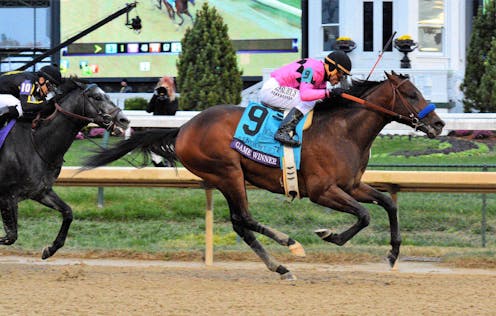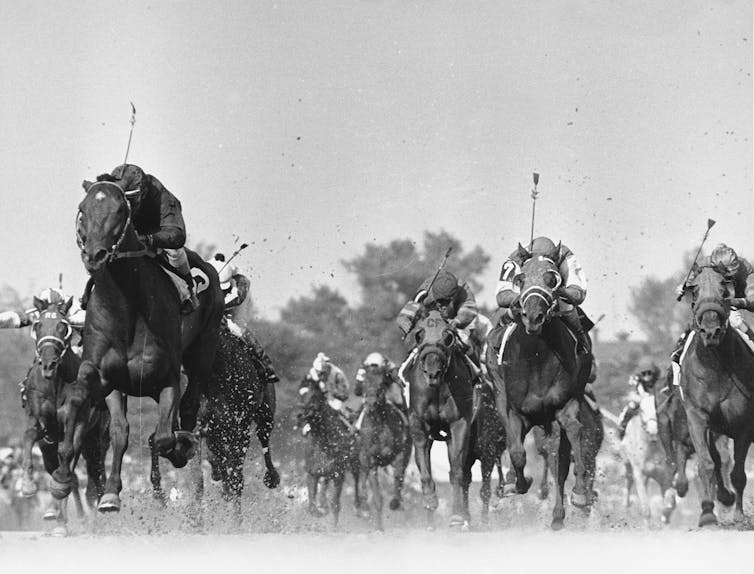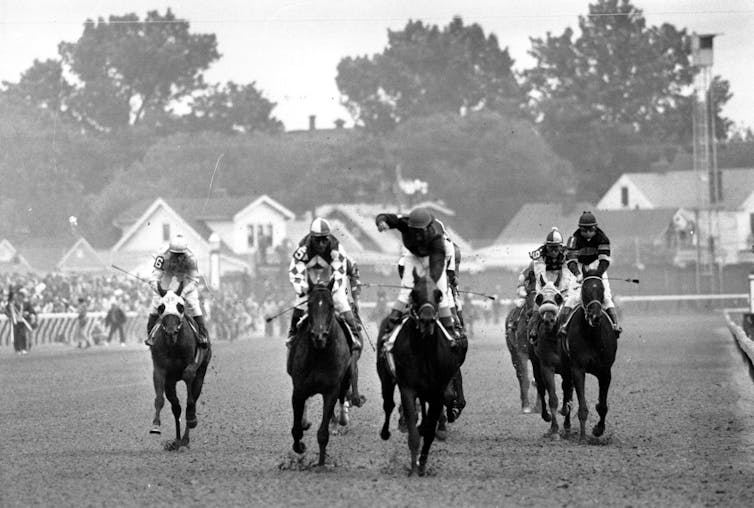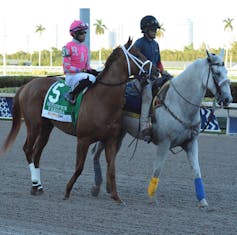The secret Latin American history of the Kentucky Derby
Many immigrants come to the United States chasing the 'American dream.' So do immigrant racehorses, who literally carry the hopes of their trainers and riders on their backs.

This Triple Crown season, which opens on May 4 with the Kentucky Derby, horses with Latin American bloodlines are among the top favorites.
Two 2019 derby contenders – Vekoma and Game Winner – are half brothers and the offspring of Candy Ride, one of Argentina’s most famous thoroughbreds. He retired, triumphant, and now shares his winning genes freely – well, for a stud fee of US$80,000 – at Lane’s End Farm in Kentucky.
That two top Derby contenders have their roots in Latin America is no surprise for those who study, as I do, the history of the sport. Many past Kentucky Derby champions hailed from the region – as have their trainers, owners and jockeys.
Cañonero II and the 1971 Kentucky Derby
The 1971 Kentucky Derby belonged to Venezuela’s Cañonero II, although few predicted it.
Announcers regularly referred to Cañonero – a 3-year-old colt with a crooked right foreleg – as the “mystery horse.” In early May 1971, the odds of him winning were long: 500-1. Few in Louisville, the mecca of American horse racing, took the Venezuelan team seriously.
“They say we are clowns,” said Cañonero’s Caracas-based trainer, Juan Arias, as Derby Day approached. “They say we are Indians because my horse gallops slowly, sometimes without a saddle.”

The trip from Caracas to Kentucky was a harrowing one. Cañonero flew to Miami a week before the Derby, where he waited for 12 hours on the plane in the Florida heat while his paperwork cleared. Then he was quarantined for four days before traveling by trailer to Louisville.
The 1,000-pound Cañonero II dropped 70 pounds in the process, but Arias wasn’t worried.
“Just relax, go eat, and we’ll wait for tomorrow,” Arias would say if Cañonero was not eager to train. Within a week, the horse had gained back his confidence – and 50 of his 70 lost pounds.
On Derby Day, a lanky Cañonero II and jockey Gustavo Avila overtook 19 horses to win by three-and-three-quarters lengths, just ahead of his American competitor Jim French – a 3-year-old so rigorously trained, many thought him indefatigable.
Nobody could believe it – except the Venezuelan team who had nurtured Cañonero from a scrawny, worm-infected colt to a global phenomenon.
“Most American trainers train for speed,” explained Arias, in Spanish, prior to the 1971 Derby. “I train Cañonero to be a star.”
Arias, Cañonero’s owner Pedro Baptista and groom Juan Quintero then set their sights on the Preakness, the second race of the Triple Crown. Cañonero won there, too, breaking a speed record set in 1955.
Cañonero and his team, now immensely popular, turned to the Belmont Stakes, in Elmont, New York – the final race of the Triple Crown. But fatigue and a bacterial infection in his hoof had weakened Cañonero. He finished fifth.
Though he didn’t win the Triple Crown, Cañonero’s dramatic victories and underdog story brought about a resurgence of interest in the sport of horse racing, according to equine journalist Steve Haskin. Attendance for the 1971 Belmont Stakes surged to 82,694, far surpassing the previous year’s record turnout of 67,961.
Among Cañonero’s fans were many Latinos, drawn to Elmont by the prospect of seeing a Venezuelan team win this quintessentially American race.
Some 2,000 Venezuelans attended the final race of the 1971 Triple Crown series, Haskin reported, wearing T-shirts emblazoned with “Viva Cañonero!” New York’s Puerto Rican community also turned out to support Cañonero in droves.
Latin American horse racing
Cañonero’s wins were a symbol of pride for Latinos and the Latin American horse racing community.
Though, historically, the vast majority of professional jockeys have come from Latin America – trained in the jockey schools which opened in the 1950s and 1960s in Panama, Puerto Rico and Mexico City – relatively few horses who compete in the U.S. were trained abroad.
Cañonero II earned his place at the Derby training against stiff competition at La Rinconada racetrack in Venezuela. His trainer, Arias, grew up poor in Caracas and fell in love with horses. There, he forged his own style of raising and communicating with horses that was different from the more regimented style of the United States.
“I can learn from American trainers,” Arias told Vault magazine after Cañonero won the Preakness. “But I can also teach them some things.”
Latin America has a long tradition of professional equestrianism.
The day after the Kentucky Derby, Puerto Rico holds the Puerto Rican Derby, run at the Camarero racetrack in Canóvanas. Each December, nine Latin American countries aim to compete in the Caribbean Derby, a premier race founded in 1966.
Just four jockeys have won both the Kentucky Derby and the Caribbean Derby. One of them is Gustavo Avila, Cañonero’s jockey.
Bold Forbes and the 1976 Kentucky Derby
In 1976 another Latin American star – the Cuban-trained and Puerto Rican-owned Bold Forbes won the Kentucky Derby and another Triple Crown race, the Belmont Stakes.
Like Cañonero II, Bold Forbes was an unlikely champion. During a dinner for trainers prior to the derby, The New York Times reported in 1976, an “undiplomatic questioner” insulted the black horse for his small stature – just 15.2 hands high – saying he looked like a filly.
“When you put a saddle on him, he kinda grows,” said Larry Barrera, the son of Bold Forbes’ Cuban trainer, Laz Barrera.
Barrera’s confidence was rightly placed. Bold Forbes ran the first half of the Kentucky Derby faster than any past Derby winner. His photo finish victory against favorite Honest Pleasure had the crowd of 115,000 roaring.
Throughout the week leading up to the Derby, Latinos went to visit Bold Forbes at the barn in Churchill Downs.
“Latins feel deeply for this horse,” Barrera told Vault magazine. “He is little … but when Cordero is on him he looks like the biggest horse in the world to Latin people.”
Puerto Rican jockey Angel Cordero, then 33 years old, called the horse “my Puerto Rican Rolls-Royce.”

Bold Forbes was the first horse to win big for Barrera, but not his last. The Cuban trainer went on to win countless races, including, in 1978, all three legs of the Triple Crown. He is the only trainer nominated to the Racing Hall of Fame in Cuba, Mexico and the United States.
Barrera saw the victories of Bold Forbes as a triumph for Latinos.
“I saw the big crowd and heard the Puerto Rican people screaming when Bold Forbes won the Belmont,” he told reporters. “Bold Forbes has a heart as big as all heaven.
"And God, I have found out, is Latin.”
Derby 2019
Latin America could see another Derby win this year.

With the favorite, owner Rick Porter’s Omaha Beach, suddenly out of the race due to illness, experts and fans are now backing Game Winner, the offspring of that venerable Argentinean runner Candy Ride, with 4-1 odds.
Candy Ride’s other offspring in the race, Vekoma, has worse odds: 15-1.
But Derby history shows that talented horses can defy expectations.
“This horse is so special that even if he didn’t love the distance, he could still win,” Vekoma’s trainer, George Weaver, told Blood Horse Magazine on April 13.
“Good horses … do what they’re not supposed to do. And this is a really smart horse who will give everything he’s got.”
E. Gabrielle Kuenzli does not work for, consult, own shares in or receive funding from any company or organisation that would benefit from this article, and has disclosed no relevant affiliations beyond their academic appointment.
Read These Next
West Antarctica’s history of rapid melting foretells sudden shifts in continent’s ‘catastrophic’ geo
A picture of what West Antarctica looked like when its ice sheet melted in the past can offer insight…
How the ‘slayer rule’ might play a role in determining who will inherit wealth from Rob Reiner and h
These rules have a long history in the United States. They played a role in the notorious murders by…
The celibate, dancing Shakers were once seen as a threat to society – 250 years later, they’re part
‘The Testament of Ann Lee,’ Mona Fastvold’s 2025 film, depicts part of the long history of Shaker…






